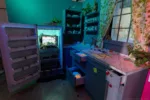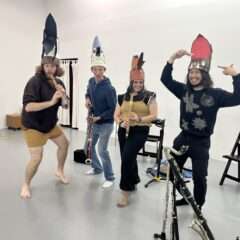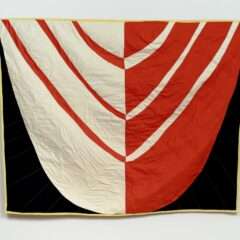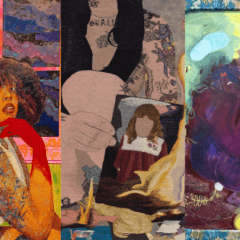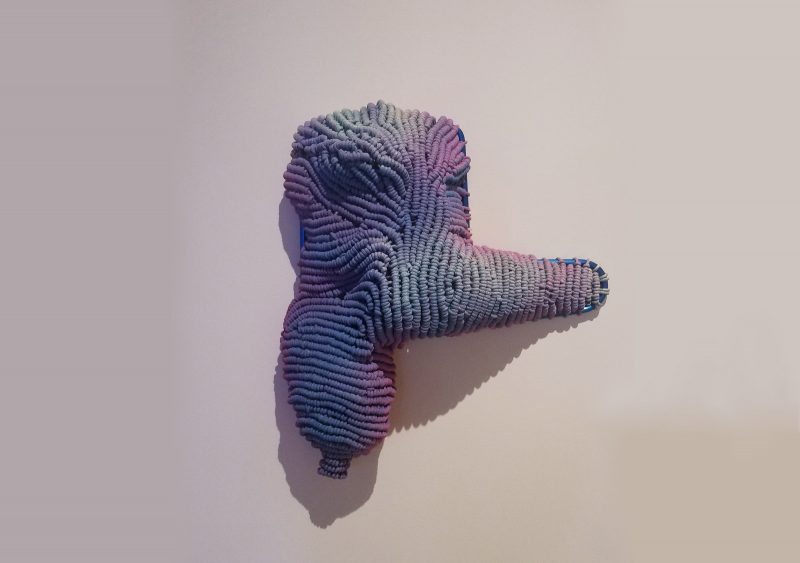
Louder Promises
by Logan Cryer
The floor was crowded by us and a hand sewn blanket fort covered us all. Warm lights filtered through the towering blue fabric and made the gallery look like dawn. This was the processing room, the optional final stop on the tour through Killjoy’s Kastle. This lesbian feminist haunted house had promised a space where we could ponder through some of the frictions it represented — changing lesbian identity, the choice many make to identify as “queer.” Are there words that describe both who we are and tell others who we want to be? With our knees all nearly touching and our bodies beginning to sweat, thirty of us stayed under that fortress and kept discussing what we thought queerness was, what it meant. Eventually someone offered, “When I call myself queer, it’s like a little promise.” My heart began to pound in agreement.
Not too much earlier that day, I had seen Jesse Harrod’s work for the first time. Mending and Repair in Response was a group show at Fleisher/Ollman gallery that featured Lisi Raskin and Jesse Harrod but, I went solely to see Harrod’s art. I knew Harrod was one of the hands that sewed the processing room into place. I knew through friends and professional ties that they were a conversant textile artist. Jesse is someone I want to know better. But I didn’t know much about textile art. In the rigidity of academia, textile and fiber art was often smothered in conversations around reminiscence or reclamation; it was as if the medium couldn’t exist without constant reassurance from the artist of its validity. Perhaps not coincidentally, textiles and fiber art is often very queer.
Once I opened the glass doors of the Fleisher/Ollman gallery, I was engulfed by an ornate piece hung abruptly in the entryway. Scarlet paracords excitedly entwined with each other and formed two curvaceous and taut curtains. Hung immediately behind them was an arch of electric blue cords, which wove into each other in shifting patterns and buckled into undulating waves. Closely following, a veil of scarlet cords hung and gave final prelude to indigo paracords that stretched down and laced into two large circles that hovered above the wooden floor. I walked through the installation, under the thousands of knots above me, to those circles. I could not pass through them without disturbing the piece with my body. I left my desire to touch unresolved.
When an artist falls in love with another artist’s work, the result is a procreational. Creative lineages are the business of the artworld and yet an artist can not love too openly or too closely, lest they be judged as a copycat, a regressor, an unproductive creator. While I walked about Mending and Repair in Response, I was educated on the genesis of the show by a staff member. The works on display, primarily consisting of textile pieces from Harrod and paintings on wooden collages by Raskin, were derived by pieces made by Joseph Yoakum, James Castle, and Eugene Von Bruenchenhein. Raskin, for example, has a painting titled, “I imagined having coffee together and remarking how high and flat the cliffs must have been in order to push against the sky that way.” It is a replication of a drawing by Yoakum and with her title, Raskin is talking directly to him, addressing both the cliffs he saw and drew and the drawing she saw and painted.
In a series of small sculptures, ropes of cotton are knitted into a swelling topography atop an aluminum frame. Overlapping layers of saturated paint accentuate their curves and create an opaque iridescence. Harrod titled this series “Mons.” Other titles they use in the show are “Bonbon” and “Von Bon,” riffing off of the name Eugene Von Bruenchenhein, whose ceramics and enamel paintings are the forms that inspired these pieces. Harrod honors Bruenchenhein by using his name. Harrod and Raskin’s titles indicate both what the artists are looking back towards and told me about who they are now. The longer I stared, the more the work vibrated with authenticity as I considered the differences between the forms they admired and the pieces before me; artists can never be exactly anything but themselves. So why not love a little more loudly?
That night, under the hand sewn blanket fort, someone listened to the whirling discussion and concluded, “When I call myself queer, it’s like a little promise. I think calling myself a lesbian could be the same.” What a dare, to name ourselves after imperfect pasts and trust who we are will not be diminished. To openly say who we admire and know we are not diminished. Those words lingered in the air as I looked around the room and made eye contact with someone whose face said the same as mine, I want to make a promise!
Bio
Logan Cryer is a writer, artist, music lover, and curator living and learning in Philadelphia. They are a graduate of Moore College of Art and Design, where they majored in Fine Arts, and an alum of Headlong Performance Institute. They have a soft spot for awkwardness and revel in the boldness that young, queer, and/or poc artists bring to the world.
Logan’s Instagram: @mercuny


